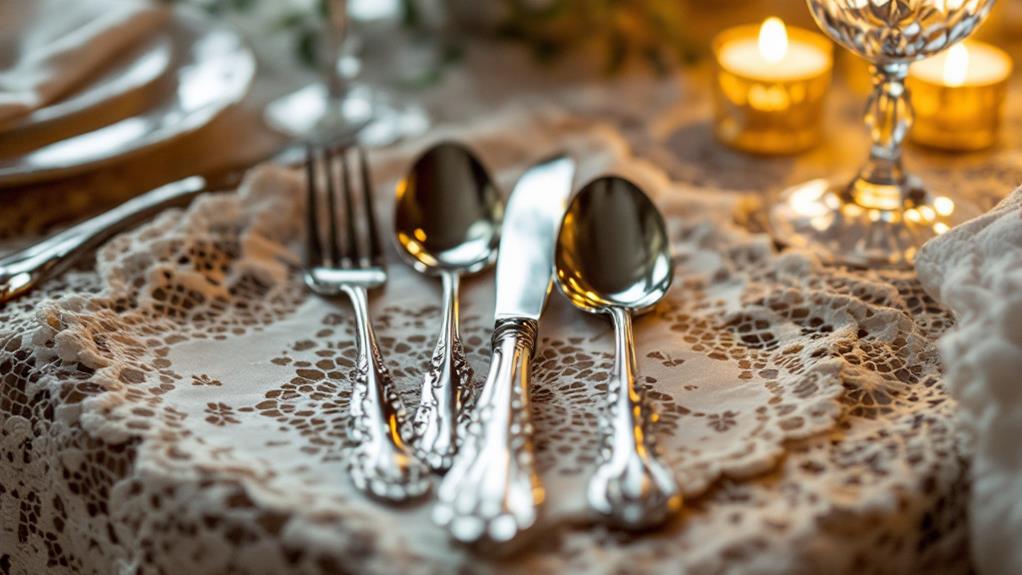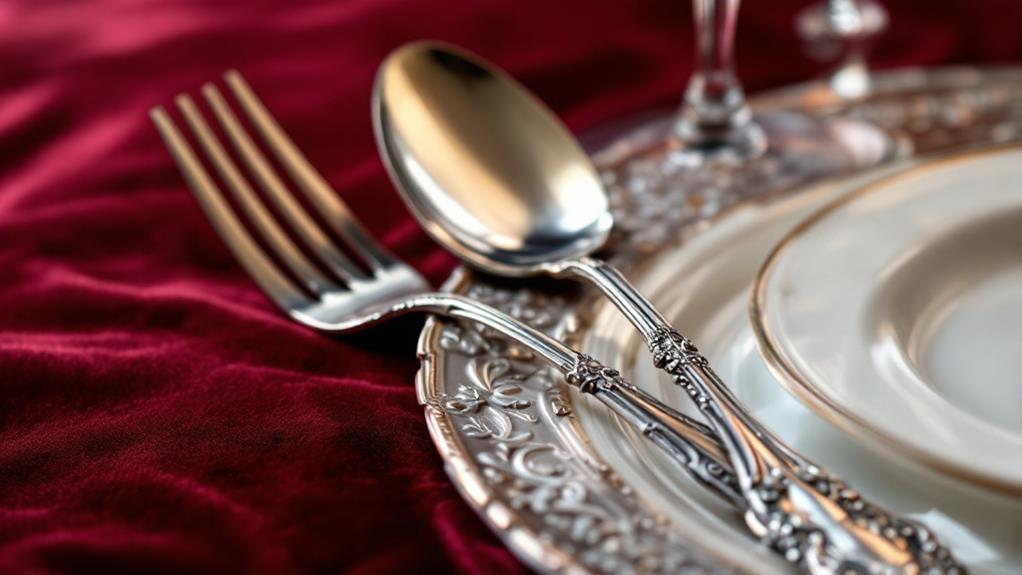Why Were Spoons Made of Silver?
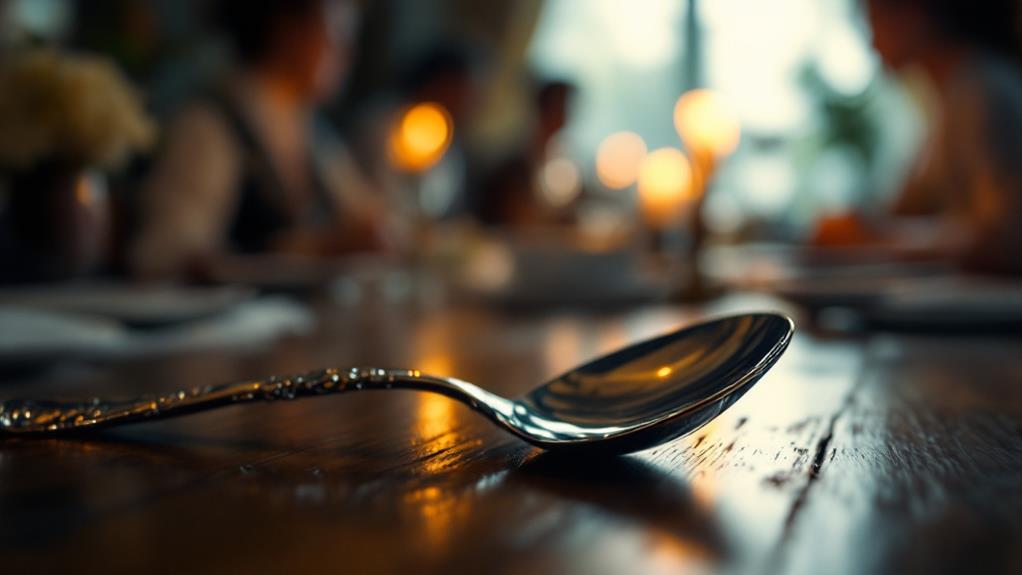
Silver spoons were crafted for several potent reasons. You'll find they possess striking antimicrobial properties, inhibiting the growth of harmful pathogens. They're incredibly durable, resisting tarnish and corrosion, which makes them excellent heirlooms. Silver's malleability allows for intricate designs, elevating their aesthetic appeal. Owning silver spoons symbolized wealth and status, distinguishing the elite from lower classes. They were versatile in dining etiquette and often given as gifts for significant life events. The combination of practical benefits and cultural significance made silver spoons highly prized possessions. There's even more to uncover about the captivating history and enduring allure of these lustrous utensils.
Historical Significance of Silver Spoons
Silver spoons have long glittered as symbols of status and privilege in society. In pre-modern times, these utensils served as more than just eating implements; they were markers of social class and membership in the land-owning elite. You might be astonishingly learn that silver spoons functioned as a combination of passport, driving license, and credit card, distinguishing individuals from serfs or escaped slaves.
The phrase "born with a silver spoon in his mouth" first appeared in print in English in 1719, highlighting the cultural significance of silver spoon ownership. Interestingly, while silver spoons indicated membership in the land-owning classes, they were primarily associated with the lower-middle class. Most members of the land-owning classes were smallhold farmers and craftsmen, who often had dirt under their fingernails.
Owning a silver spoon set you apart from those who worked the land, as it suggested you didn't need to engage in manual labor. This distinction was indispensable in a society where social status was closely tied to occupation and property ownership. Silver spoons, hence, became powerful symbols of one's place in the social hierarchy.
Silver's Antimicrobial Properties
Beyond their status as symbols of wealth, silver spoons offered a practical advantage that made them priceless in pre-modern times. The secret lies in silver's remarkable antimicrobial properties. When you use a silver spoon, you're benefiting from its natural ability to kill microorganisms, making it an exceptionally hygienic choice for dining utensils.
Ancient civilizations recognized silver's power to purify water and prevent food spoilage. The Phoenicians, for instance, used silver vessels to keep their water clean, a vital benefit in an era before modern sanitation. This antimicrobial effect, known as the oligodynamic effect, allows silver to inhibit the growth of a wide range of pathogens, including bacteria, viruses, and fungi.
Compared to wooden or bone utensils, silver spoons were less likely to harbor harmful bacteria. This made them a healthier option for dining, especially in times when hygiene was a constant concern. As people began to understand the connection between silver and cleanliness, the popularity of silver spoons soared. Their antibacterial nature became a key factor in their widespread adoption and enduring association with hygiene throughout history.
Symbol of Wealth and Status
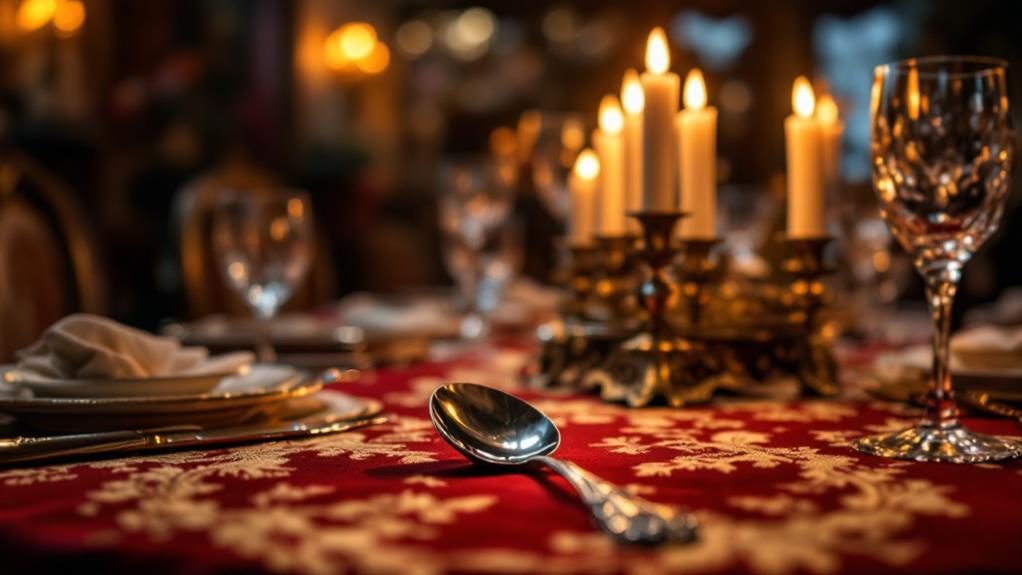
While silver spoons' antimicrobial properties made them practical, their true allure lay in their symbolism of wealth and status. In pre-modern times, owning silver spoons wasn't just about having fancy utensils; it was a way to show you belonged to the land-owning elite. These precious objects served as a multifunctional identifier, similar to how we use passports, driving licenses, and credit cards today.
The phrase "born with a silver spoon in his mouth," dating back to 1719, highlights the long-standing association between silver spoons and privilege. Interestingly, it wasn't just the upper class who prized these items. Lower-middle-class individuals, such as smallhold farmers and craftsmen, also used silver spoons as cultural markers.
Imagine you're living in those times. Owning silver spoons would mean:
- You're part of the land-owning class
- You can distinguish yourself from serfs or escaped slaves
- You have a symbol of your social status
- You possess a significant, multi-purpose identifier
Even today, we use the term "silverware" generically, regardless of the actual material, showcasing the enduring cultural significance of silver as a symbol of affluence.
Durability and Longevity
Durability stands as a hallmark feature of silver spoons, setting them apart from their counterparts made of other materials. When you invest in silver spoons, you're choosing a utensil that will outlast wooden, bone, or pewter alternatives. The exceptional longevity of silver spoons makes them a wise choice for those who can afford the initial cost.
You'll find that silver's resistance to tarnishing and corrosion guarantees your spoons remain in excellent condition, even with daily use. This durability allows silver spoons to be passed down through generations, becoming cherished family heirlooms. The malleability of silver also contributes to its longevity, as it can be easily shaped and formed into intricate designs that are difficult to achieve with other metals.
When you use silver spoons, you're not just enjoying a symbol of wealth and status; you're benefiting from a practical and long-lasting utensil. The exceptional durability of silver spoons means they'll continue to grace your table for years to come, maintaining their beauty and functionality long after other materials have worn out or degraded.
Versatility in Dining Etiquette
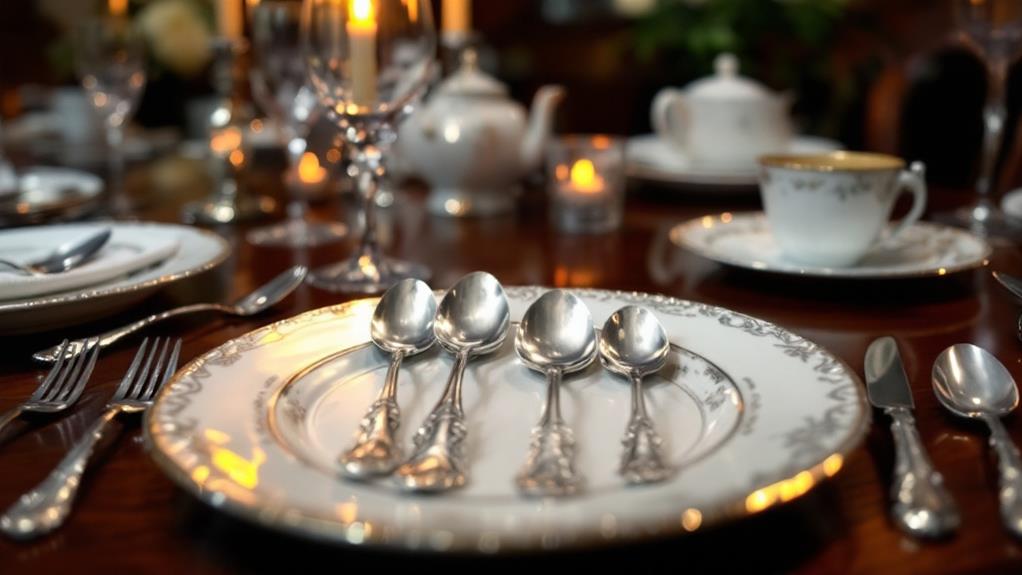
The versatility of silver spoons in dining etiquette extends far beyond their durability. As you plunge into the world of fine dining, you'll uncover that silver spoons were often used for various purposes, each with its own set of rules and customs. These precious utensils became an integral part of table settings, with specific types designed for different courses and beverages.
Silver spoons made their mark in dining etiquette through their diverse applications:
- Tea spoons for stirring and sipping hot beverages
- Dessert spoons for enjoying sweet treats
- Soup spoons for savoring broths and chowders
- Serving spoons for distributing food from communal dishes
You'd find that owning a complete set of silver spoons wasn't just about having the right tool for each dish. It also served as a symbol of your social status and refined taste. The ability to use the correct spoon for each course demonstrated your knowledge of proper etiquette, further cementing the silver spoon's role in high society. As you negotiate formal dinners, you'd rely on your silver spoons to guide you through the meal, showcasing your understanding of dining customs and your place in the social hierarchy.
Cultural Traditions and Gifting
Beyond their practical uses, silver spoons played a significant role in cultural traditions and gift-giving practices. You'd often find these precious utensils being presented as tokens to mark significant life events. Christenings and weddings were prime occasions where silver spoons became cherished gifts, symbolizing affluence and prestige.
For young brides, silver spoons held special importance. They were frequently included as part of a dowry, with sets of these esteemed utensils accompanying the bride into her new life. This tradition underlined the cultural significance of silver spoons as markers of social class and family prominence.
The phrase "born with a silver spoon in one's mouth" emerged from this cultural milieu, highlighting the association between silver spoons and privilege. Owning these spoons wasn't just about having fancy cutlery; it was a way to distinguish yourself in society. In pre-modern times, you could even use a silver spoon as a form of identification, setting yourself apart from serfs or escaped slaves. As silver became synonymous with wealth and status, these spoons evolved into powerful symbols of social standing and familial legacy.
Aesthetic Appeal and Craftsmanship
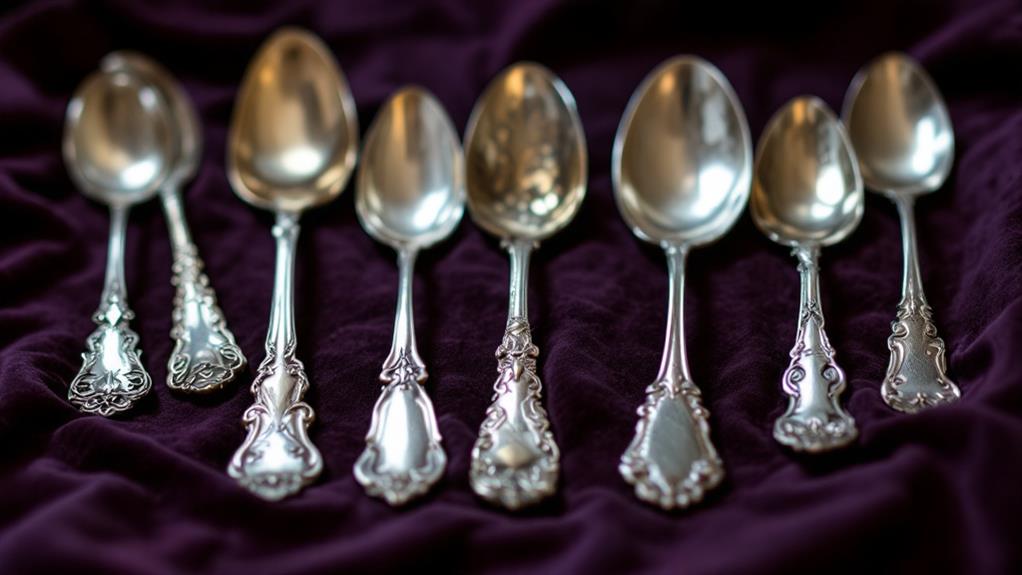
In addition to their practical benefits, silver spoons enraptured users with their stunning aesthetic appeal and exquisite craftsmanship. You'd be mesmerized by the lustrous shine of a well-polished silver spoon, its gleaming surface reflecting light in a way that no other material could match. The phrase "born with a silver spoon in your mouth" wasn't just about wealth; it also alluded to the higher value placed on these beautiful utensils.
Silver's malleability allowed skilled silversmiths to create intricate designs that transformed simple eating tools into works of art. You'd marvel at:
- Delicately engraved patterns on the handle
- Ornate filigree work adorning the stem
- Embossed family crests or monograms
- Elaborately shaped bowl ends
These decorative elements weren't just for show; they represented the pinnacle of craftsmanship and artistry. The time and skill required to produce such detailed work further elevated the status of silver spoons. As family heirlooms, these spoons carried both monetary and sentimental value, passing down through generations as treasured possessions that reflected a family's history and prestige. The combination of beauty and craftsmanship made silver spoons coveted items that surpassed their practical use.
Investment and Heirloom Value
While silver spoons gleamed with their beauty, their true value extended far beyond mere aesthetics. You'd find that silver spoons were prized for their durability and resistance to tarnishing, making them an excellent long-term investment. These qualities guaranteed that serving spoons and other utensils used to make meals could be passed down through generations, becoming cherished family heirlooms.
The high cost of silver spoons restricted their ownership to the upper classes, signifying wealth and social status. You'd often see them given as christening gifts or included in a bride's dowry, further cementing their role in family traditions. This practice set the wealthy apart from the lower classes, who were limited to using cheaper materials like copper or pewter for their utensils.
Silver spoons' value made them attractive to thieves, reinforcing their status as symbols of affluence. By owning and using silver spoons, you'd be making a clear statement about your place in the social hierarchy. Their ability to indicate the presence of poison added to their practical value, making them a wise investment for those who could afford them.
Evolution of Silverware Manufacturing
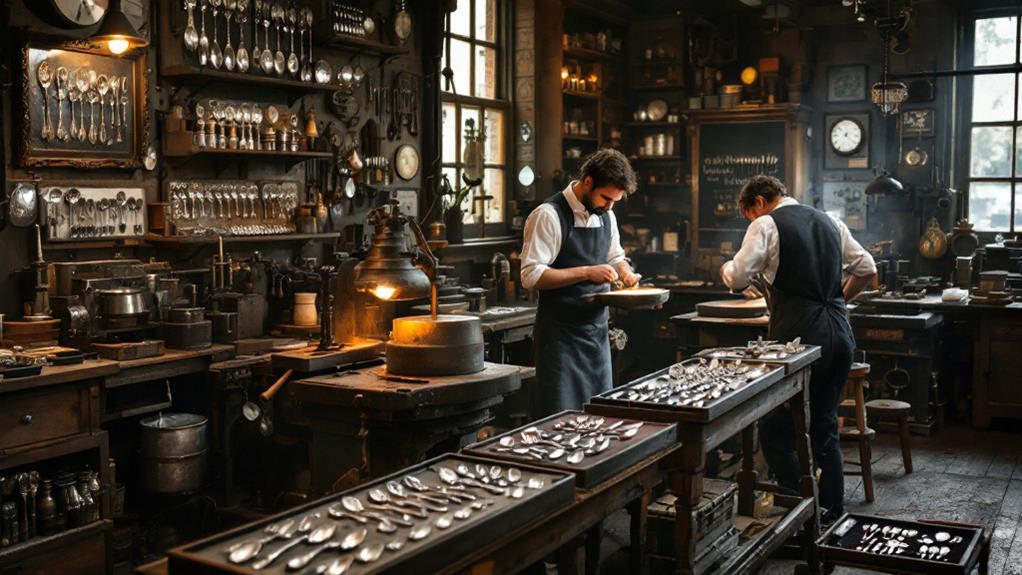
Throughout history, you'd see the evolution of silverware manufacturing reflect advancements in technology and changing societal needs. From primitive bone and stone tools, silverware production has come a long way. The Romans were among the first to widely adopt silver for their utensils, recognizing its sophisticated and durable properties.
As manufacturing techniques improved, silver utensils became more refined. The bowl shape of spoons, for instance, evolved to better suit various dining purposes. Silver's popularity grew due to its:
- Antimicrobial properties
- Ability to purify water
- Durability compared to other metals
- Association with wealth and status
However, the high cost of silver meant that only the wealthy could afford these utensils. This exclusivity led to the term "silverware" becoming synonymous with luxury and affluence.
In modern times, the introduction of stainless steel has revolutionized utensil manufacturing. While silver remains a popular choice for its elegance and investment value, stainless steel offers a more affordable and practical alternative. Today, "silverware" has become a generic term encompassing various materials and finishes, from genuine silver to silver-plated items and even stainless steel utensils.

